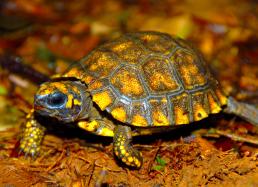11. The Past Two Years
During my last dispatch from the field, we'd just completed our presentations to officials in three different cities: Iquitos and Quito in Ecuador, and Lima, Peru. After returning home, we spent the next eight months writing up our Final Report (in English and Spanish), detailing a case for the long-term conservation of the area:
- The Güeppi-Cuyabeno region is spectacularly diverse: species richness of several biological groups—plants, fishes, amphibians and reptiles, birds, and mammals—is among the highest of any other region on the planet.
- The forest and wetland complexes sprawl over a huge area, with limited access by humans. This has confined most commercial exploitation to peripheral areas accessible by rivers and navigable streams, leaving large core areas that function as resources for game populations and safe havens for the myriad other native species, known and unknown, that live there (see Photos #1 and #2 below.)
- Indigenous peoples—Cofan, Secoya, Kichwa, Huitoto, and others—have a deep history in the region. Centuries of turbulence and adaptation to external pressures, such as the rubber boom of the late 1800s and early 1900s, have forced major changes in their social, political, and economic structures.
- Yet these indigenous communities still depend on the forests, wetlands, and rivers for sustenance and other benefits that offer them a high quality of life. Their interest in retaining their cultures, their local-grown models for the wise use of resources, and their strong support for intact forests and clean waters make them powerful and central allies in conservation (see Photo #3 below.)
We believe two factors warrant immediate action. The government of Peru is now considering the designation of a new national park (Parque Nacional Güeppí) and two new communal reserves (Reserva Comunal Airo Pai and R. C. Huimeki). This inventory aims to move that process forward.
Meanwhile, a huge petroleum claim (Lote 117 of Petrobras) has been superposed on the entire Zona Reservada Güeppí. It represents a severe threat to wildlife and human communities. Our goal in this Rapid Inventory is to emphasize the extraordinary biological and cultural value of the region, to aid local residents in their fight to protect the area, and to support plans already well developed by Peru, Ecuador, and Colombia to manage the region as a 1.7-million hectare “conservation corridor.”
I can report that our progress is slow but steady, and there are several very positive notes. In October of 2008, Debby Moskovits gave a very well-received presentation of our results to a tri-national (Colombia, Ecuador, Peru) working group in Quito, Ecuador. Dozens of reports have been distributed to key decision-makers.
In 2009, World Wildlife Fund offices in Peru, Ecuador, and Colombia received European funds to bring together the management of the tri-national area as a corridor. And Peru has a new environmental ministry, Ministerio del Medio Ambiente, that places environmental issues on par with all other issues of national interest.
However, the Zona Reservada Güeppí is still not a formally declared conservation area, and the oil concession still overlaps the area in its entirety in Peru. We continue to work with governmental and non-governmental agencies to move the conservation process forward. The conservation process, even with compelling results in hand, is often long and complicated.
On a heartening note, in August 2009, the Peruvian government formally declared the Reserva National Matsés, a terrifically diverse area where we conducted an inventory with the Matsés indigenous people in 2004. With determination and perseverance, the conservation results can be spectacular.
As I sign off, I want to extend my deepest thanks to this team—17 biologists, 5 social scientists, dozens of Secoya and Cofan indigenous scientists—and the people living along the Napo and Putumayo rivers and their tributaries. What an amazing group! I know we all feel privileged to have spent three weeks exploring the spectacular forests and communities in Cuyabeno and Güeppí.
I would also like to extend a very special thanks to Nancy Hamill Winter and The Hamill Family Foundation for supporting this work—you are the ones that made all of this possible, and we are incredibly grateful. And finally, I would like to thank those of you have been following along on our expedition and have forwarded our dispatches to your friends and families. Helping expose new audiences to the beauty, richness, and value of the Amazon wilderness and spreading the word about the plight and progress of those who are working to protect it contributes greatly to the success of our efforts. Your role as message bearer is invaluable, and for that we cannot thank you enough.
Some of you have also expressed a desire to make an impact in a more material way. To accomplish this, I invite you to consider supporting our programs via a Restricted Gift to Conservation. As you know, securing long-term sustainability for threatened ecosystems is a challenge, and funding is crucial. We thank you again for joining us in our partnership for change.
Corine



